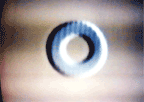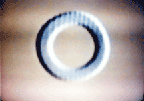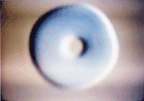"Evolution Is Relentless: Analog is but a Dream..."
by Carol Goss
(An excerpt of the essay appears in The Squealor, winter/spring
2004 issue, pages 12-13,
a publication of Buffalo Media Resources)
We are still at the very beginning of the history
of recorded motion images. This includes: the stroboscope, the kinetoscope,
20th century cinema and DVDs. I directed a one act play for NBC-TV
in Washington DC in 1968 - before videotape. We are now nearly post-disc.
Analog is but a dream, and that means not only analog video, but also film.
Evolution is relentless.
From the artist's perspective, however, technology
should be additive, not subtractive or competitive. There is no way
to compare images captured with a tube camera, fed through an oscillator
and then into an analog colorizer, with images captured digitally and then
altered and animated on a computer. The vivid color of Topography,
created on the Paik-Abe Synthesizer, is one of the first video pieces I
made at the Experimental Television Center. The analog circuitry
of the board allowed ‘illegal’ color signals, which would accumulate, intensify
and alter hues at the borders of shapes.
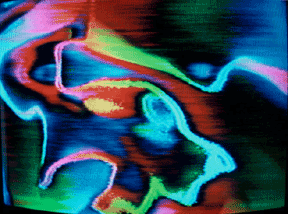
Topography © Carol Goss 1974
In a recent piece, Zwischenraum, digitally
taped images are altered in the computer and then arranged in constantly
shifting relationships.
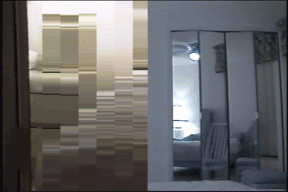
Zwischenraum © Carol Goss 2003
Analog is lush, hot and dangerous. Digital
is cool, precise and discrete. There is a qualitative difference
between them that goes beyond issues of resolution. The immediacy
of analog synthesis meant we could do live performance in the 1970s, creating
and animating images in real-time. This is only possible just now
with computers. The specificity of digital meant we could have loss-less
dubs and do field accurate postproduction. This was very difficult with analog.
The era we see in the rear view mirror, the pre-urban
time when humans related primarily to Nature, is analog in character.
It is magnetic, influenced by the stars, with undulating rhythms.
The era we are now deep into is the Machine Age. It began with the
Enlightenment, gained momentum with the Industrial Revolution, and now is
pervasive. The Machine Age is digital in character.
Quantum physics assures us of the simultaneous absolute
and relative positions of electrons. The analog paradigm is the electron
oscillating between two addresses. The digital paradigm is the electron
having a fixed address.
Here are three images from Rings/Lovers, a
piece in which the image is very slowly transformed. The rhythm is
rather like the waxing and waning of the moon.
The RF feedback and tube camera made the three-dimensional
illusion possible, but you have to believe it before you can see it.
Motion resulted from the interplay between the artist and the feedback loop,
which was alive. The analog image creation process relies more on
aesthetic intuition than rational technique.
Early digital animation allowed more control of form.
These images from S-Construct are staccato with very dramatic linear
punctuations. Each change of shape was hand drawn. Motion had to be
simulated in a frame editing process similar to cell animation in film.
The above images from Rings/Lovers and S-Construct
convey the essential differences between analog and digital motion imaging.
When creating a new piece, however, technology is not the primary concern.
One meditates on a relationship and uses the instruments at hand to express
the implications of that relationship. Ultimately, it all becomes
a whole, and the media and its content become inseparable.
The Not Still Art Festival, which I first organized
in 1996, screens abstract and non-narrative electronic motion imaging.
Initially there were video pieces and animated pieces. Now there are
pieces combining both and it is impossible to know where the animation begins
and the video leaves off. The hyperrealism direction digital animation
took for so many years is now modified by more painterly 2D visions.
Digital promises us much. And eventually digital
will approximate analog. Particle animation can create dirty, noisy
surfaces and “natural” movement, which simulates the laws of physics, instead
of following them. We will be able to create and collaborate in these
virtual environments in real-time.
It is a richness to have the option to be loose and
erratic or obsessive and exact. In Zwischenraum machines are
juxtaposed with nature. You see and here the fans, the cars, the birds,
the heat, the ice. There is a play of opposites. I like to
name pieces after they are completed. Only then do I know what they
are saying. Zwischenraum is a German word in physics which means
“the space between things.” The Japanese have a wonderful understanding
of empty space, which in the West we call “negative space”. Most likely
it is the concept of ‘digital’ which provoked my meditation on this space
between things. The result is a piece which plays with time, place
and sensation. The ‘how” and the ‘why’ of the piece are now inextricably
entwined.
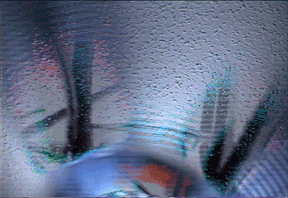
Zwischenraum © Carol Goss 2003
Author: Carol Goss co-founded Improvising Artists with jazz pianist,
Paul Bley, in 1974 and the Not Still Art Festival in 1996. She has
collaborated with Walter Wright, Skip Sweeney, Steve Rutt, William S. Burroughs,
Jaco Pastorius, Pat Metheny and others. ImprovArt.com distributes her
work and she is currently editing a book of her collected essays, entitled
Driven to Abstraction, for Berkeley Hills Books.
This essay and all images and video are copyrighted
by Carol Goss 2004. All Rights Reserved
Return to Home Page



